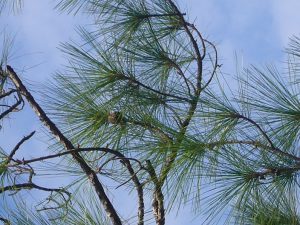For some, it is easy to tell a pine tree from, say, an oak tree, but can you tell a pine tree from a pine tree? Some might say it’s a pain in the neck to properly identify certain pine species. Here, we are going to explore three different pine species commonly found in Pinellas County. I mean, we are called “Pine-ellas” county after all (Spanish origin meaning “point of pines”) so the least we can do is know how to identify the pine species we have here.
The Big Picture
Let’s start off with the big picture of what makes a pine a pine. Just like we can lump people into broad categories of race and gender, we can lump trees into broad categories too. In the case of pines, they would be in the broad category of gymnosperms. This might be going way back for some of you, but remember the whole gymnosperm versus angiosperm concept? Okay, okay I’ll help you out…gymnosperms being plants whose seeds are not protected by an ovary or fruit. Gymnosperms include conifers, cycads and ginkgo.
The Smaller Picture
Pines fall in the conifer (cone bearing) category and specifically in the Pinaceae family. We can think of plant families like our extended family; there are some similar characteristics among family members (hair, height, eye color, etc.) that help us recognize that they might be related. Also similar to extended family, there are several “families” that make up the larger family coming from a common descendent. In the Pinaceae family there are the larches (Larix spp.), Douglas-firs (Pseudotsuga spp.), firs (Abies spp.), spruces (Picea spp.), pines (Pinus spp.) and hemlocks (Tsuga spp.).
All of the above genera are evergreen (with the exception of Larix), monoecious (male and female reproductive organs on the same plant) have needle-like or linear leaves, cones, and resinous wood.
The Pines
When we go from extended family to immediate family, we start to see even more similar characteristics. This brings us from the broad Pinaceae family to the genera of pines (Pinus spp.). Within your immediate family, you know that individuals are all different. There are different personalities, different appearances, and even different names. Individual family members can be seen as different “species” in the tree world so we can assign trees a first name (Genus) and a last name (specific epithet). There are seven species of Pines in Florida, but only three commonly found in Pinellas County.
The three pines include: slash pine (Pinus elliottii), longleaf pine (Pinus palustris), and sand pine (Pinus clausa). We will start with the easiest one to identify, the sand pine.
Sand Pine

Sand pines are easy to tell apart from slash pine and longleaf pine:
- First, the overall structure is very different. Sand pines retain their lower branches and only grow to about 60 ft. tall.
- Second, their needles are small (only 2.5-3.5 inches) and come in bundles or fascicles of 2.
That’s pretty much all you need to know to tell sand pine apart from the other two pine species in Pinellas. One down, two to go!
Fun fact: Sand pines keep their lower branches because they have serotinous cones which are covered with a resin that must be melted for the cone to open up and release its seeds. The lower branches help to encourage a prescribed fire or wildfire up the tree, serving as a “fire ladder” to ensure cones are opened, while the parent tree sacrifices its life for its young.
Slash Pine vs. Longleaf Pine
Slash pines and longleaf pines both self-prune their lower branches giving them a very different overall appearance than sand pine. Where it can get tricky is telling slash pine from longleaf pine. In general, everything about longleaf pine is bigger or longer than slash pines.
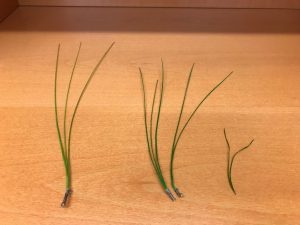
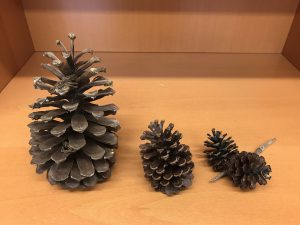
| Slash Pine | Longleaf Pine |
| Needles (7-12 inches) are in bundles (called fascicles) of 2s and 3s. Appear more sparsely vegetated at end of branch.
|
Needles (10-18 inches) in fascicles of 3s (occasionally 4s). Densely crowded at end of branch with more droopy appearance due to length of leaves and the pull of gravity. |
| Mature seed cones are 3-7 inches long with a shiny, tan color. | Mature seed cones are 6-10 inches long more dull brown in color. |
| Bark of mature trees has broad and flat scaly plates that are orange-brown in color. (don’t rely on bark only for ID) | Similar to slash pine, but more irregular in appearance with less distinct “plates”. |
| Thinner (like diameter of adult pinky) where twig meets cluster of needs at end of branch. | Thicker (like diameter of adult thumb) where twig meets cluster of needs at end of branch. |
| Thinner and greener “candle” or terminal bud evident in late winter/early spring. | Thicker, silvery-white “candle” or terminal bud evident in late winter/early spring. |
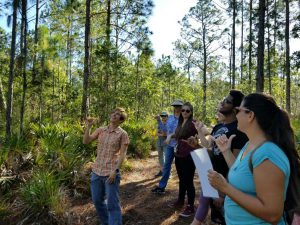
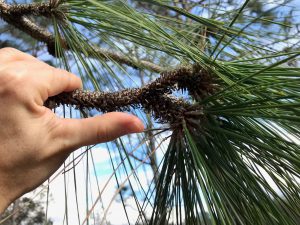
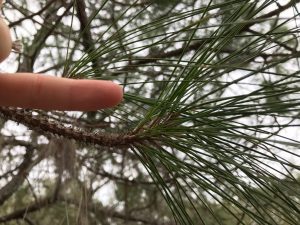
Hopefully next time you go to identify a pine in Pinellas County, it won’t be as much of a “pine in the neck” 😉
Note: Another species of pine that can be found in Pinellas County is loblolly pine (Pinus taeda) though not common. Furthermore, Australian Pine (Casuarina equisetifolia) is not a true pine and is not native to Florida.
Happy Learning!
Idea for this blog came from an old interpretive guided hike script found at Brooker Creek Preserve Environmental Education Center. Thank you to the staff member that inspired me!
If you enjoyed this series and would like to read more about commonly confused plants and animals in Florida, you can find more here:
https://blogs.ifas.ufl.edu/global/tag/commonly-confused/
Sources:
http://www.pinellascounty.org/about_pinellas.htm
Native Trees of the Southeast: An Identification Guide by L. Katherine Kirkman, Claud L. Brown and Donald J. Leopold
https://edis.ifas.ufl.edu/pdffiles/FR/FR00300.pdf
 3
3
